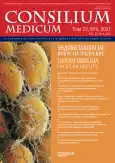Evaluation of calcium level in patients with diabetes mellitus according to the examination in the mobile medical center (Diamodule)
- Authors: Zheleznyakova A.V.1, Volodicheva V.L.1, Vikulova O.K.1, Serkov A.A.1, Eremkina A.K.1, Shestakova M.V.1, Mokrysheva N.G.1
-
Affiliations:
- Endocrinology Research Centre
- Issue: Vol 23, No 4 (2021)
- Pages: 382-388
- Section: Articles
- URL: https://journals.rcsi.science/2075-1753/article/view/95460
- DOI: https://doi.org/10.26442/20751753.2021.4.200834
- ID: 95460
Cite item
Full Text
Abstract
Full Text
##article.viewOnOriginalSite##About the authors
Anna V. Zheleznyakova
Endocrinology Research Centre
Email: azhelez@gmail.com
канд. мед. наук, ст. науч. сотр. отд-ния эпидемиологии Moscow, Russia
Victoriya L. Volodicheva
Endocrinology Research Centreнауч. сотр. отд-ния патологии околощитовидных желез Moscow, Russia
Olga K. Vikulova
Endocrinology Research Centreканд. мед. наук, доц., зав. отд-нием эпидемиологии Moscow, Russia
Alexey A. Serkov
Endocrinology Research Centreвед. инженер Moscow, Russia
Anna K. Eremkina
Endocrinology Research Centreканд. мед. наук, ст. науч. сотр. Moscow, Russia
Marina V. Shestakova
Endocrinology Research Centreакад. РАН Moscow, Russia
Natalia G. Mokrysheva
Endocrinology Research Centreчл.-кор. РАН, д-р мед. наук, проф., дир. Moscow, Russia
References
- Дедов И.И., Шестакова М.В., Викулова О.К., и др. Атлас регистра сахарного диабета Российской Федерации. Статус 2018 г. Сахарный диабет. 2019;22(2S):4-61
- Шестакова М.В., Викулова О.К., Железнякова А.В., и др. Эпидемиология сахарного диабета в Российской Федерации: что изменилось за последнее десятилетие? Терапевтический архив. 2019;91(10):4-13
- Шамхалова М.Ш., Викулова О.К., Железнякова А.В., и др. Эпидемиология хронической болезни почек в Российской Федерации по данным Федерального регистра взрослых пациентов с сахарным диабетом (2013-2016 гг.). Сахарный диабет. 2018;21(3):160-9
- Ермоленко В.М., Ветчинникова О.Н., Волгина Г.В., и др. Минеральные и костные нарушения при хронической болезни почек. Национальные рекомендации. 2015
- Moldovan D, Rusu C, Kacso IM, et al. Mineral and bone disorders, morbidity and mortality in end-stage renal failure patients on chronic dialysis. Clujul Med. 2016;89(1):94-103. doi: 10.15386/cjmed-515
- Seifert ME, Hruska KA. The Kidney-Vascular-Bone Axis in the Chronic Kidney Disease-Mineral Bone Disorder. Transplantation. 2016;100(3):497-505. doi: 10.1097/TP.0000000000000903
- Lecka-Czernik B. Diabetes, bone and glucose-lowering agents: basic biology. Diabetologia. 2017;60:1163-9. doi: 10.1007/s00125-017-4269-4
- Дедов И.И., Шестакова М.В., Сунцов Ю.И., и др. Результаты реализации подпрограммы «Сахарный диабет» Федеральной целевой программы «Предупреждение и борьба с социально значимыми заболеваниями 2007-2012 годы». Сахарный диабет. 2013;16(2S):1-48
- Викулова О.К., Железнякова А.В., Исаков М.А., и др. Динамический анализ состояния углеводного обмена в субъектах Российской Федерации по данным мобильного медицинского центра (Диамодуль) и регистра сахарного диабета Российской Федерации. Сахарный диабет. 2020;23(2):104-12
- Железнякова А.В., Викулова О.К., Серков А.А., и др. Динамический мониторинг сердечно-сосудистых заболеваний у пациентов с сахарным диабетом по данным обследования в мобильном медицинском центре (Диамодуль) в регионах России. Consilium Medicum. 2020;22(10): 39-44
- Дедов И.И., Шестакова М.В., Майоров А.Ю., и др. Алгоритмы специализированной медицинской помощи больным сахарным диабетом. Вып. 9. Сахарный диабет. 2019;22(1S1):1-144
- Бирагова М.С., Грачева С.А., Мартынов С.А. Нарушения фосфорно-кальциевого обмена у пациентов с сахарным диабетом и хронической болезнью почек. Сахарный диабет. 2012;15(4):74-80
- Хантакова Е.А., Хамнуева Л.Ю., Орлова Г.М. Анализ фосфорно-кальциевого обмена и функции паращитовидных желез у больных сахарным диабетом 1 типа. Сахарный диабет. 2013;16(4):33-7
- Шепелькевич А.П. Состояние показателей фосфорно-кальциевого обмена у пациентов с сахарным диабетом 1-го типа. Военная медицина. 2012;25:93-102
- Bonds DE, Larson JC, Schwartz AV, et al. Risk of Fracture in Women with Type 2 Diabetes: the Women’s Health Initiative Observational Study. J Clin Endocr Metab. 2006;91(9):3404-10. doi: 10.1210/jc.2006-0614
- Shah VN, Shah CS, Snell-Bergeon JK. Type 1 diabetes and risk of fracture: meta-analysis and review of the literature. Diabet Med. 2015;32:1134-42.
- Weber DR, Haynes K, Leonard MB, et al. Type 1 diabetes is associated with an increased risk of fracture across the life span: a population-based cohort study using The Health Improvement Network (THIN). Diabetes Care. 2015;38:1913-20.
- Janghorbani M, Van Dam RM, Willett WC, Hu FB. Systematic review of type 1 and type 2 diabetes mellitus and risk of fracture. Am J Epidemiol. 2007;166:495-505.
- Holmberg AH, Johnell O, Nilsson PM, et al. Risk factors for fragility fracture in middle age. A prospective population-based study of 33,000 men and women. Osteoporos Int. 2006;17:1065-77.
- Ялочкина Т.О., Белая Ж.Е.,Рожинская Л.Я., и др. Переломы костей при сахарном диабете 2 типа: распространенность и факторы риска. Сахарный диабет. 2016;19(5):359-65
- Shahwan MJ, Khattab MH, Jairoun AA. Association of Serum Calcium Level with Waist Circumference and Other Biochemical Health-care Predictors among Patients with Type 2 Diabetes. J Pharm Bioallied Sci. 2019;11(3):292-8.
Supplementary files






